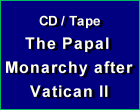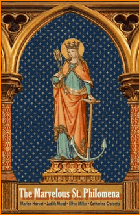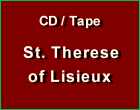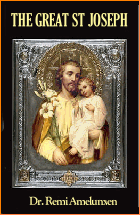Symbolism
 |
 |
 |
 |
 |
 |
 |
The Rich Symbolism of the Dove
Birds and animals often do not fare well in the medieval bestiaries, which seek the underlying symbols of the creatures of Creation. The medieval mind understood that the effects of original sin were felt by everything in the paradisiacal garden; thus, they perceived both the good and evil significances of every creature that surrounded us.
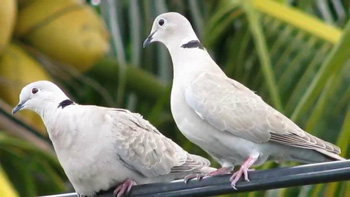 So, for example, we have ass or donkey, which bore Our Lady to and from Bethlehem, presented as a symbol of humility. On the other hand, because of its stupid bray and stubbornness, it also symbolized a person who has deficient understanding, who hears the wisdom of the Gospel but is unable to comprehend it.
So, for example, we have ass or donkey, which bore Our Lady to and from Bethlehem, presented as a symbol of humility. On the other hand, because of its stupid bray and stubbornness, it also symbolized a person who has deficient understanding, who hears the wisdom of the Gospel but is unable to comprehend it.
But the dove comes out with flying colors as a symbol of the Holy Spirit, the faithful Catholic, the Holy Eucharist, and chastity and fidelity in love.
The chaste dove
Let us go first to the famous medieval Bestiary Physiologus, whose author is believed to have been the Abbot of Monte Casino in the early 11th century.
The first part of the symbolism of the dove composed in poem form (1) describes the fidelity in love of the chaste dove. For it only takes one mate for its whole life, remaining with its mate day and night. If its spouse dies, it never seeks another, but spends the rest of its life apart from the other birds in mourning. Thus, it sits not on a branch in full leaf but on a dry stem, and instead of singing, it sighs. Thus, it ever carries its mate in its heart and, we are told, "always remains chaste."
The second part of the Bestiary poem presents the allegory or symbolic interpretation. (2) Just as the turtle dove forever remains united to its one mate, so also the faithful soul, once united to Christ in Baptism, remains always at His side, never separating itself from Him by mortal sin.
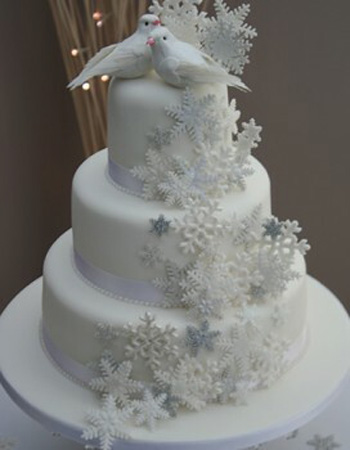 And just as the dove never seeks another spouse should the latter die, always keeping its chastity inviolate, so also the faithful soul remains faithful to his heavenly Spouse, even if deprived of the consolations of grace and devotion. He should not turn to the things of the flesh, but recall to mind the times of joy together, always faithful.
And just as the dove never seeks another spouse should the latter die, always keeping its chastity inviolate, so also the faithful soul remains faithful to his heavenly Spouse, even if deprived of the consolations of grace and devotion. He should not turn to the things of the flesh, but recall to mind the times of joy together, always faithful.
That is why the dove does not rest on the green branch, seeking the delights of the world, but sits on the dry stem, which represents true sorrow and penitence of heart. This is how the faithful Catholic awaits the coming of his Spouse who will come on the Day of Judgment to judge him and all men.
We can see why two doves, chaste and faithful to each other for life, are symbols used to represent couples in wedding decor and cards. Two doves on a funeral monument sometimes signify the conjugal love and fidelity of the couple buried there.
Spiritual significances of the dove
From the times of the early Church, doves appear in the catacombs representing the souls of departed Catholics. In pictures of dying martyrs, for example, a dove issues from the mouth soaring upward to Heaven.
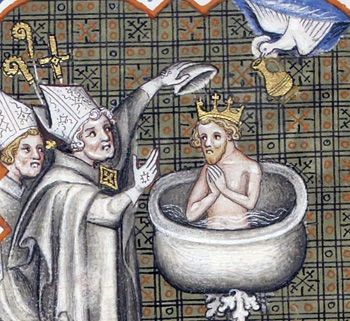 When the dove is shown bearing an olive branch in its beak, it refers to Noah and ark, symbolizing the soul of the Catholic who always returns to the Church, the true ark of salvation, as the only place of safety and rest.
When the dove is shown bearing an olive branch in its beak, it refers to Noah and ark, symbolizing the soul of the Catholic who always returns to the Church, the true ark of salvation, as the only place of safety and rest.
Most often, however, the dove signifies the Holy Spirit, the Third Person of the Trinity. As the Gospel tells us, when Our Lord was baptized, as He came forth from the water, "the heavens were opened to Him, and He saw the Spirit of God descending as a dove, and coming upon Him" (Mt 3:16). In fact, all four Evangelists record the appearance of the Holy Spirit in the form of a dove at the Baptism of Christ.
By the Middle Ages the usual method of representing the Trinity showed Our Lord hanging on the Cross, God the Father sitting crowned and throned behind Him, and the Dove over His Head. A dove of gold was hung up in the baptistery at Reims after the baptism of Clovis, for during that ceremony a dove from Heaven descended carrying in its beak the vial of Holy Oil, which was used thereafter to anoint all the Kings of France until it was destroyed in 1793 by the French revolutionaries. After this miraculous event, a dove frequently appeared suspended over or carved into baptismal fonts in churches and cathedrals.
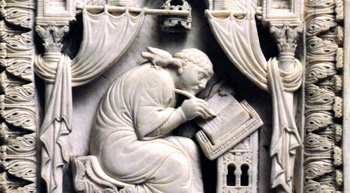 The dove also represented the inspiration of the Holy Spirit. Thus, St. Gregory the Great is often represented with a dove on his shoulder, whispering words of divine guidance.
The dove also represented the inspiration of the Holy Spirit. Thus, St. Gregory the Great is often represented with a dove on his shoulder, whispering words of divine guidance.
So closely is the dove associated with the Holy Spirit that seven doves are used to symbolize Its Seven Gifts, and twelve doves the twelve fruits of the Holy Spirit. The dove surrounded with seven flames serves as a symbol of Confirmation
As a Eucharistic vessel
Since early medieval times, the Holy Eucharist reserved for the use of the sick was kept in a vessel made of gold or silver in the form of dove – an emblem of the Holy Spirit – which was suspended by chains to the baldachino [awning] and hung above the altar.
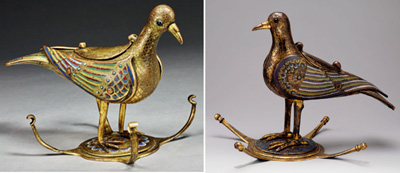 Tertullian speaks of the Church as columbae domus, the house of the dove, a sign of the use of such vessels in the 3rd century. Until today, the pyx that carries the consecrated Host often has a dove engraved or enameled on it also.
Tertullian speaks of the Church as columbae domus, the house of the dove, a sign of the use of such vessels in the 3rd century. Until today, the pyx that carries the consecrated Host often has a dove engraved or enameled on it also.
In this context, the dove can also represent the soul fed by the Holy Eucharist. On the 11th century baptismal font of Winchester Cathedral, for example, we see two doves approaching to drink out of a vase in which is planted a jeweled cross, symbolizing the consecrated wine. Two doves pecking at bread symbolize the soul fed by the Eucharist.
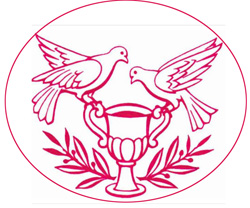


Two turtle doves, a symbol of chaste spouses
But the dove comes out with flying colors as a symbol of the Holy Spirit, the faithful Catholic, the Holy Eucharist, and chastity and fidelity in love.
The chaste dove
Let us go first to the famous medieval Bestiary Physiologus, whose author is believed to have been the Abbot of Monte Casino in the early 11th century.
The first part of the symbolism of the dove composed in poem form (1) describes the fidelity in love of the chaste dove. For it only takes one mate for its whole life, remaining with its mate day and night. If its spouse dies, it never seeks another, but spends the rest of its life apart from the other birds in mourning. Thus, it sits not on a branch in full leaf but on a dry stem, and instead of singing, it sighs. Thus, it ever carries its mate in its heart and, we are told, "always remains chaste."
The second part of the Bestiary poem presents the allegory or symbolic interpretation. (2) Just as the turtle dove forever remains united to its one mate, so also the faithful soul, once united to Christ in Baptism, remains always at His side, never separating itself from Him by mortal sin.

Doves in wedding cakes - a common wedding symbol
That is why the dove does not rest on the green branch, seeking the delights of the world, but sits on the dry stem, which represents true sorrow and penitence of heart. This is how the faithful Catholic awaits the coming of his Spouse who will come on the Day of Judgment to judge him and all men.
We can see why two doves, chaste and faithful to each other for life, are symbols used to represent couples in wedding decor and cards. Two doves on a funeral monument sometimes signify the conjugal love and fidelity of the couple buried there.
Spiritual significances of the dove
From the times of the early Church, doves appear in the catacombs representing the souls of departed Catholics. In pictures of dying martyrs, for example, a dove issues from the mouth soaring upward to Heaven.

A dove from Heaven bringing the holy chrism to anoint Clovis at his baptism on Christmas, 508 AD
Most often, however, the dove signifies the Holy Spirit, the Third Person of the Trinity. As the Gospel tells us, when Our Lord was baptized, as He came forth from the water, "the heavens were opened to Him, and He saw the Spirit of God descending as a dove, and coming upon Him" (Mt 3:16). In fact, all four Evangelists record the appearance of the Holy Spirit in the form of a dove at the Baptism of Christ.
By the Middle Ages the usual method of representing the Trinity showed Our Lord hanging on the Cross, God the Father sitting crowned and throned behind Him, and the Dove over His Head. A dove of gold was hung up in the baptistery at Reims after the baptism of Clovis, for during that ceremony a dove from Heaven descended carrying in its beak the vial of Holy Oil, which was used thereafter to anoint all the Kings of France until it was destroyed in 1793 by the French revolutionaries. After this miraculous event, a dove frequently appeared suspended over or carved into baptismal fonts in churches and cathedrals.

The Holy Spirit as a dove inspiring St. Gregory
So closely is the dove associated with the Holy Spirit that seven doves are used to symbolize Its Seven Gifts, and twelve doves the twelve fruits of the Holy Spirit. The dove surrounded with seven flames serves as a symbol of Confirmation
As a Eucharistic vessel
Since early medieval times, the Holy Eucharist reserved for the use of the sick was kept in a vessel made of gold or silver in the form of dove – an emblem of the Holy Spirit – which was suspended by chains to the baldachino [awning] and hung above the altar.

Medieval eucharistic vessels in the shape of a dove
In this context, the dove can also represent the soul fed by the Holy Eucharist. On the 11th century baptismal font of Winchester Cathedral, for example, we see two doves approaching to drink out of a vase in which is planted a jeweled cross, symbolizing the consecrated wine. Two doves pecking at bread symbolize the soul fed by the Eucharist.

- "Doves like the turtle vainly love never,
Mated to one love, clings to him ever,
Always is with him, whatever befall,
By day, or by night, ne’er leaves him at all,
None will e’er see her from him far apart,
Deep as she may feel the pain of her heart
Reflect of him, no mate shareth her lone nest,
Lone is her day’s flight, lone is her night’s rest,
Living, his image in her heart reigneth,
Keeping herself hid, chaste she remaineth."
(Physiologus, London: John & Edward Bumpus, Ltd., 1928), p. 93. - "Thus the soul stands fast faithful forever,
Blest in the strong bond failing it never,
Christ is its true Spouse also its dear Lord,
When the heart’s truly full filled with Christ’s word,
Those living near Him live well to life’s end,
Having Him always, ne’er want a true friend,
Although ’tis said Christ descends into Hell,
That soul, which knows Him in heaven to dwell,
Holds itself waiting His coming to share,
And for the judgment itself doth prepare."
Ibid., p.93- 94.

Posted December 21, 2017
______________________
______________________



